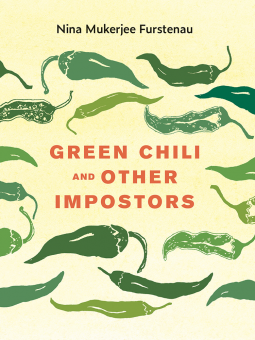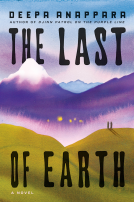
Green Chili and Other Impostors
by Nina Mukerjee Furstenau
This title was previously available on NetGalley and is now archived.
Send NetGalley books directly to your Kindle or Kindle app
1
To read on a Kindle or Kindle app, please add kindle@netgalley.com as an approved email address to receive files in your Amazon account. Click here for step-by-step instructions.
2
Also find your Kindle email address within your Amazon account, and enter it here.
Pub Date Nov 01 2021 | Archive Date Nov 01 2021
University of Iowa Press | University Of Iowa Press
Talking about this book? Use #GreenChiliandOtherImpostors #NetGalley. More hashtag tips!
Description
Food history is a world heritage story that has all the drama of a tense thriller or maybe a mystery. Whose food is it? Who gets to tell its tale? Respect for food history might tame the accusations of appropriation, but what is at stake as food traditions and biodiversity ebb away is the great, and not always good, story of us.
Advance Praise
“In this delightful book, Nina Mukerjee Furstenau plays sharp-eyed detective and amiable guide as she traces essential Bengali ingredients along histories that are as surprising and creative as the cooks they inspire. Each ingredient in Green Chili and Other Impostors leads to a deeper understanding of how foods, gathered from all over the world, are claimed and made at home—a global story that Furstenau makes personal in luscious prose. I’ll never look at a green chili—or any of these delicious dishes—the same way again.”—Kate Lebo, author, The Book of Difficult Fruit: Arguments for the Tart, Tender, and Unruly
“A compelling book with a remarkable mix of history, personal insights, and a genuine investment in making connections across continents, generations, and disciplines. I loved its wonderfully eclectic mix of themes, in terms of ingredients, communities, and historical traditions. My absolute favorite is the section on the kaffir lime or gondhoraj lebu—so delightfully counterintuitive!”—Jayanta Sengupta, director, Victoria Memorial Hall, Kolkata, India
“I was mesmerized by this ambitious book—a blend of memoir, research, and food lore—from start to finish. From inside her farmhouse kitchen in Missouri to the home of a traditional cheesemaker outside Kolkata, from the fish pond in her grandmother’s garden to the tea gardens of Makaibari, I walked with the author as she took me to multiple, flavor-rich worlds.”—Sayantani Dasgupta, author, Women Who Misbehave
Available Editions
| EDITION | Other Format |
| ISBN | 9781609387983 |
| PRICE | $17.00 (USD) |
| PAGES | 240 |
Average rating from 27 members
Featured Reviews
 sara a, Reviewer
sara a, Reviewer
This book delighted me in many ways. It is not a cookbook, but it has intriguing recipes. It is not a textbook, but it traces history and food origins with tantalizing stories. It is not a travelogue, but it describes both Kansas and India. It is not a memoir, but the author's life is a huge part of this book. Put it all together and you have all the ingredients for a fascinating read about the foods of India.
I am not a particular fan of Indian food, but I still enjoyed reading this book and it made me more interested in trying different types of Indian food. I particularly enjoyed knowing of the rich and varied dishes of India. The writing is lovely and it reads smoothly. It should appeal to a wide range of readers.
Thank you to NetGalley for an advance copy of this book.
This book is even better than expected. The title didn't provide enough insight into how great this book would be. Very enjoyable story of an American of Indian parentage who grew up in the Midwest. The author shares her journey as a Fulbright-Nehru Global Scholar examining the foods of the Kolkata, Bengal, India. She weaves in some of her life story of childhood trips there and growing up as a minority in her Midwest town. Her writing style is very engaging. She then provides a series of recipes mixed with information (including historical information) about the ingredients in the recipes. She also provides tips for the recipes from her own experiences cooking. She even covers the Ayurvedic perspectives. Highly recommend for foodies and all people who enjoy Indian food.
*This book was received as an Advanced Reviewer's Copy from NetGalley.
This book turned out to be more than I could imagine. I read the description, and knew that it traced ingredients and their history through Indian cuisine. Origins, uses, arguments over provenance; it was surprising to learn about chilis, rice, and many other ingredients and how they were incorporated into Indian food, and when. I guess the one I had always taken for granted and not thought about origin was the chili (so the title is apt on this one to call it out); I'll let the book give you its history, but I really would have expected a longer one.
Which just tells me how much I still have to learn and that this book was definitely a lot of new information that I gobbled right down. I was also extremely pleased that it included recipes, and plan to try a few. Sourcing some ingredients may be difficult, but we have some wonderful stores nearby that hopefully I can. But even more surprising, was the relationship between these ingredients, and the stories told by the author of her childhood and experience with the ingredients and dishes. And how she came to be on this food tour of India. I was engrossed in her stories and instead of it detracting from the book (which often times personal anecdotes can do), it instead added quite a bit and made the book more relatable. My only real complaint was that the last few chapters seemed to rush, and I was so immersed that I would have loved the detail the first few had.
If you enjoy reading about food history (and don't mind a few good recipes), this is a book to check out!
Review by M. Reynard 2021
I was gifted an e-ARC copy of this book to review in exchange for my honest opinions. For this, I would like to thank the author and the publisher.
"Green Chili and Other Imposters" is, in its essence, a family story - Furstenau acknowledges as such in the very first pages of the introduction. She longs to understand the cuisine of her culture and family in a much deeper way. Her travels to find the thread of her cuisine lead her in turn to every corner of the world; from Peru to Mongolia, and from the United States to China. This leads to the questions that are tantamount to the research that Furstenau has done: who owns cuisine? Who can tell its story? What does an ingredient have to do to "belong?"
I thoroughly enjoyed this journey through the history of the world to trace ingredients that one may think are synonymous with Indian food, but who have only become essentials in relatively recent history. Crops such as potatoes, tomatoes, and yes, the titular green chili have come from all over the world as a result of trade and migration. These have inserted themselves into Indian cuisine so firmly that Westerners can no longer think of Indian food without them. But those who practice traditional Indian cooking from centuries ago know when and how the ingredients came to the subcontinent.
Following Furstenau along the trail of these discoveries was a delight. Her writing is personal while still conveying the academic importance of the subject. Personal anecdotes and sensory details put you in the streets of Kolkata with her. I particularly enjoyed learning about the histories of minorities - Jews, Armenians, and Chinese among them - in India, and the ways that they have helped shape the food culture of the country overall.
A few things I felt could have been done better. Furstenau uses in-text citations in a conversational manner rather than footnotes. While this does make it feel more personal than academic, the lengthy titles of some books and articles caused the sentences to feel clunky and interrupted my flow of reading. I also felt that they made her sound like more of a reporter than an official who can be quoted in her own right. All academic writing is reporting with our own conclusions added in; however, footnotes I believe would have helped this book seem more like a source to be quoted rather than a collection of other sources, while helping ease the flow of the words.
I also felt that some of the chapters could have had a tighter focus. It took me by surprise when I was reading about tea and then suddenly chili chicken. The thread that binds them is, of course, Chinese migration in India but I would have liked them to be their own separate chapters. That, or that the chapter was more explicitly about broad Chinese influences and then married the stories of tea and chili chicken together more seamlessly.
Overall, this book completely opened my curiosity into the history of Indian food, and of foodways in general. Furstenau's passion and knowledge of the subject comes through really well. I recommend this to anyone who is pursuing knowledge on these topics. With a few structure tweaks, this would easily be a 5 star read. I look forward to doing my own further research on some of the topics mentioned within!
I really enjoyed this book - I loved the stories and science behind the recipes. I can't wait to utilize it more when it is chili season!
 Michele S, Reviewer
Michele S, Reviewer
As a person living in Southwest America, I was expecting this book to be another green chili recipe book. I happen to love green chili and missed it immensely when I moved to the East coast. This book came as a surprise when I realized the recipes were Indian dishes. While light on actual recipes, this book is a great history of food, especially as it relates to Indian cuisine. I love food and history, so this book is actually perfect for me. Overall, this work feels like hearing the stories while cooking in a grandmother's kitchen. It has a long list of references, so more sophisticated than your average cookbook. Honestly, this work would be a great gift for an eccentric person like myself as I am always seeking to learn about other cultures, especially as it relates to food.
Part travel memoir, part personal memoir, and part food history; it's an intriguing combination. Furstenau discusses her own history - born of Bengali parents, in Thailand, and then growing up in the US. Throughout the book are comments about how hard it was to demonstrate that her visa to India ought to reflect that heritage, but given a lack of paperwork for her parents, it wasn't to be. This sense of questioning where she belongs is woven through her discussion of "Indian" food, as she looks into the histories of both ingredients and dishes. "Indian" because some of what is discussed is about how now-common ingredients in Indian food actually came to India (green peas, chillis, potato... cheese...); and also some things you might think of as Indian are not, and some things appropriated by others are, of course, from India.
The author travels around India, sometimes visiting relatives and sometimes finding food-connected people, who talk about history and share recipes and teach her to cook some of the dishes. And these recipes are included, of course - Sandesh and Nolen Gur Cheesecake; Kedgeree (which is Indian, not Scottish, and the story of it becoming a breakfast staple is fascinating and I have never eaten it!); Koraishutir Kochuri (puffed bread with green pea filling, and goodness I really want to make this)... and so many others.
This book is very readable; it's enjoyable to journey around India, it's varied in what ingredients and ideas it discusses, and the recipes seem easy to follow.
Green Chili and Other Impostors by Nina Mukerjee Furstenau is a lovely book that can be utilised in so many ways. You can read it as a history book exploring Bengali cuisine and culture, you can read it as a cooking book with many recipes pulling from Bengali cuisine, Jewish Bengali cuisine, Chinese Indian cuisine, Armenian Bengali cuisine and more, you can read it as an autobiography of one person's journey through their heritage, or a book of curiosities, learning about the 6,000 varieties of rice, or how much the Silver Tips Imperial tea from the Makaibari Tea Estate in Kurseong sold for in 2014.
Nina is a wonderfully generous author. She's warm with her suggestion of substitutions, aware that there are some ingredients that may be difficult or even impossible to get depending on where you are in the world, but she also describes the ingredients used with such love that you'll want to make a real effort to get your hands on items you've never cooked with before. As a cookbook (and this book is so much more than a cookbook), the recipes are straight-forward and well-described.
I enjoyed how thoughtful each chapter was, often focusing on a different food, or cuisine, tracing the movements of potatoes or rice or even tea, and talking openly about colonialisation and racism and appropriation and generosity and politics in ways that feel delicate and eye-opening, and inspire curiosity and learning. There are subjects here that absolutely need to be brought up, but I feel like Nina seasons her writing the way she may her food, with attention and love.
I had to take my time with this. Each chapter does introduce you to amazing threads of information, and sometimes I found myself stopping reading to explore a subject further on Wikipedia. Nina dances from subject to subject, but by the end of a chapter you may find yourself realising that you've learned about 20 different things - cultures, foods, trades, curiosities - and be left reeling with how big the world can be, only to realise you have many more chapters to go! Sometimes it feels like it almost loses focus, but it reminds me of how it can feel to travel somewhere else at times, your senses can't quite keep track, but get to ground back into food again - as you do at the end of most of the chapters with the shared recipes.
I really liked getting to sink my teeth into this review copy. And it does feel like a richly meaty book. You can flit into it for the recipes, or you can go really deep into the chapters, and it's going to be rewarding no matter how you read it. I'd recommend this to so many different readers, obviously people who enjoy cooking Bengali cuisine or want to know more about it, but also people who want to learn more about food heritage, food culture, cultural melting pots and the food stories that come out of them, and anyone who has ever struggled with a heritage that derives from two or more countries, wondering where home is for them, and what home means. This book is its own homecoming, even as it explores the idea of home in the foods we eat and love.
 Jocelyn H, Reviewer
Jocelyn H, Reviewer
Green Chili and Other Impostors is a great book for anyone interested in learning more about the history and culture of food in India.
It's part memoir/travelogue, part history book, and part cookbook. At times I found it a bit unfocused and sometimes wished more time was spent on a deeper dive of a particular historical topic before going back to, say, visa troubles, but on the whole I learned a lot about various ethnic groups in India, the importance of food in religion, and the paths of different ingredients and dishes across the centuries.
I occasionally found the transitions from food history to the author's travel and life experiences a little jarring, and sometimes hard to follow. It's not a big problem, but she does tend to wax poetic and interrupts a story about the importance of a potato with things like:
A moist sliver of potato flies off the chopping block and lands on the counter. Hello there, food, I murmur until I catch myself, then retrieve the small deviant.
It's not really my thing. I'd really rather just learn about the potato.
That being said, she does have a real talent for describing food, and her writing is fantastic at getting across what each dish is like. Everything she mentioned sounded delicious and vivid in my imagination!
The end taste of Sankar's fish molee is piquant, creamy on the tongue, with a hint of citrus and a touch of spice.
Really gets the salivary glands going, right?
Overall, this was a great introduction to a slice of India's food history and its connections to other cultures and countries. Green Chili and Other Impostors gives many popular dishes some cultural context while introducing other, less well-known ones. And of course, I have a number of Bengali dishes I'm eager to try out now!
Green Chili and Other Impostors is a well written nonfiction book full of food lore, history, and trivia written and presented by Nina Mukerjee Furstenau. Due out 1st Nov 2021 from the University of Iowa Press, it's 240 pages and will be available in paperback and ebook formats.
This is a fun and interesting book for foodies, complete with recipes. The book grew out of the author's working trip to Kolkata on a Fulbright study grant and contains reminiscences and history both of her own childhood and life (as an Indian American in Kansas) as well as the deeper, richer fusion of India's traditional cuisine from a blended and varied history as a cultural crossroads and melting pot from antiquity to the present day.
The chapters are arranged whimsically and (somewhat) thematically: dairy, limes, grains, "imposters" (foods which are traditional but not indigenous such as chilies), potatoes, fusion cuisine, peas, British(ish) desserts, several less thematic chapters covering varied memories and reminiscences, Armenian/Indian with cultural anthropological ruminations, religious observance and temple food (with a discussion of the truly staggering logistics involved in feeding so many thousands of temple visitors, monks, and the gods themselves), and "curry" with all its geopolitical ramifications.
Recipes are written with a title and description followed by ingredients in a bullet list sidebar. Measurements are given in US standard only. Special tools and ingredients are also listed, along with yields and cooking directions. Nutritional info is not included. Many of the ingredients will be easily sourced at any moderately well stocked grocery store. The difficult to acquire ingredients are often listed with substitutions. I would imagine that larger metropolitan areas will have access to Asian/Indian/World Foods stores which will have the more esoteric (for the USA) ingredients available. The book also includes a short metric conversion chart. I noticed a few errors in the pre-release ARC given for review which will almost certainly be corrected in the final print release: for example, the conversion instructions for pounds to kilograms are to multiply by 453.6 (that should be grams, not kg).
The recipes are not photographed and there are no serving suggestions or presentations. The graphics are simple and contain a number of well rendered maps and monochrome facsimiles, but no food pictures. The recipes are varied and well developed, but it's the background cultural and historical thoughts which really shine in this collection.
Four stars. A good choice for food-and-culture-interested readers, public and school library acquisition, and gifting to food interested friends and family.
Disclosure: I received an ARC at no cost from the author/publisher for review purposes.
 Reviewer 446334
Reviewer 446334
A great combination of a travelogue, a cookbook, an analysis of history, and an emotional memoir. With a focus on Bengali food, the author lays down and often contemplates the origins, influences, and impact of the various ingredients that have not only been an integral part of her life but are also integrated through intergenerational stories, historical tales, and the mystery of food heritage.
 Reviewer 774738
Reviewer 774738
The book starts the author's personal history and how the food of her people of Bengal is eaten today. And herein starts our rabbit hole of finding out more about this cuisine and its various ingredients.
The chapters are arranged according to food groups like grains and dairy etc. The imposters are any food not indigenous to India. Their origins and their enthusiastic cultural acceptance is discussed.
Food created from trade with nearby countries and the ensuing foods that it churned out and how it has been changed to appease to local taste buds are all covered. Food items introduced due to colonisation are also mentioned.
Nina has a definite way with words. Its like the food in her mouth churned out the very words which the feeling evokes. The book is largely information and historically driven. It does have recipes but more importance is given to how it all came out. Would have definitely preferred more pictures though.
Thank you University of Iowa and netgalley for this Arc.
I love love love this style of cookbook. The personal notes and touch on each ingredient and dish appeals to many fans of food writing, while making the subsequent recipes in the chapter feel easy to navigate and do-able. This book is also clearly well-researched and fact checked, it is noticeable the passion, intelligence and heart that stirred this book together. It was a joy to read and to learn more about the food History of India and would be thrilled to read more food journeys by this author.


















